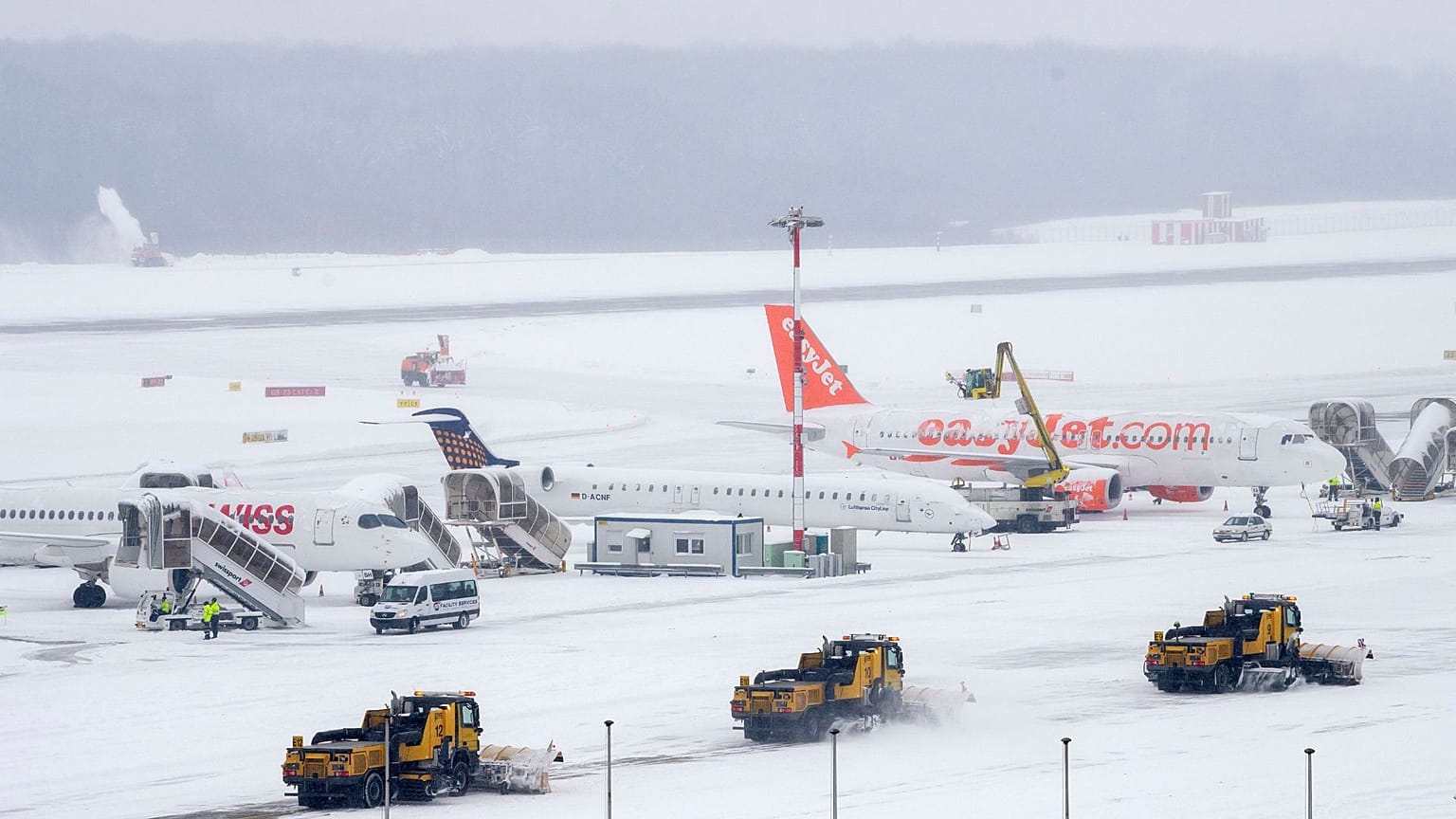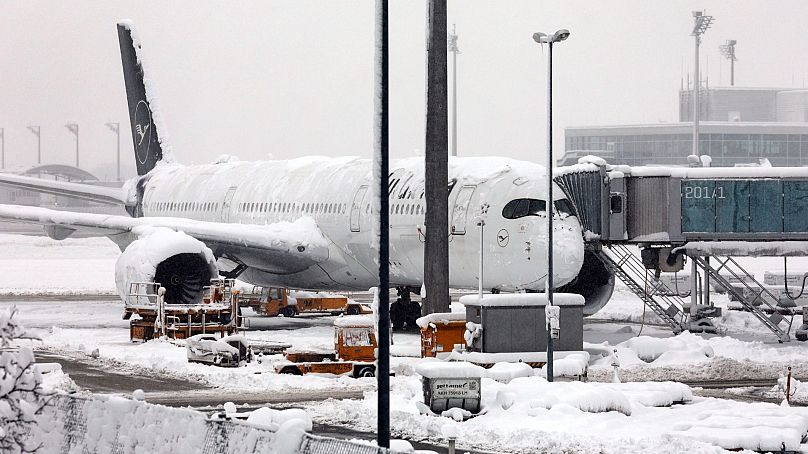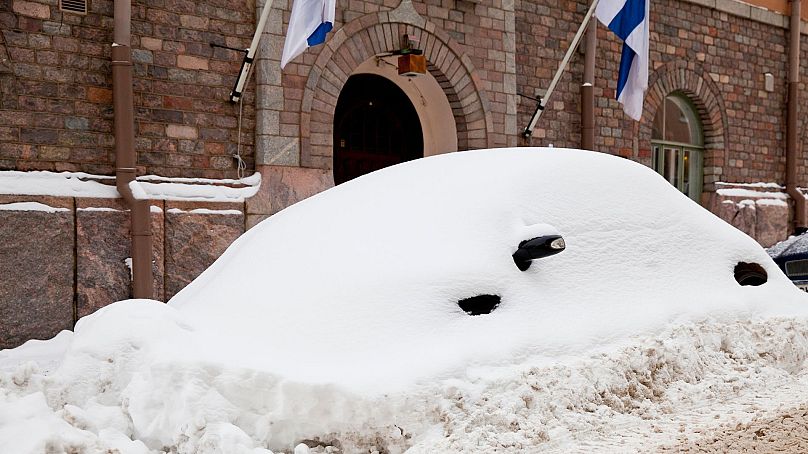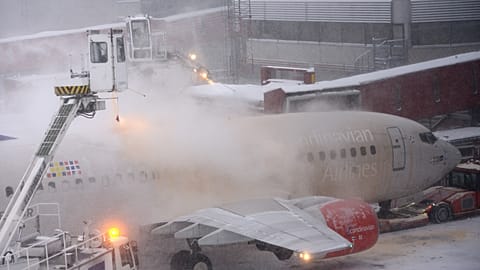Helsinki Airport clears runway snow in just 11 minutes. Why can’t the UK and Germany always do the same?
Munich Airport ground to a standstill this week after heavy snowfall and freezing rain made safe flight operations impossible.
Passengers took to social media to express their dismay at delays and cancellations. One X (formerly Twitter) user suggested the German airport look to Helsinki in Finland for tips.
“Please talk to the airport in Helsinki. Much more snow and much more difficult weather conditions,” they posted. “They can clean a runway full of snow in 11 minutes. It is really time to level up.”
So why is it that some airports are better able to cope with snow than others?
According to Munich Airport, the weather conditions are not comparable. Temperatures around freezing point, like those experienced in Germany, create wet snow. This tends to turn to slush and ice, which is harder to clear than dry ice.
In Nordic countries like Finland, meanwhile, consistently lower winter temperatures in the minus 2-4°C range make the snow drier and firmer. This type of powder can be more easily swept or blown away.
How does winter weather affect air travel?
Ice and snowfall create challenging conditions for air travel, from skidding off the runway to low visibility.
Freezing rain, like that experienced in Munich this week, is particularly troublesome.
This is when supercooled water freezes on impact with surfaces like runways and aeroplanes. It is one of the most “challenging elements” for airport maintenance, a spokesperson for Finavia, the company responsible for maintaining Finland's airport network, tells Euronews Travel.
“When supercooled water rains on a runway or on the surface of an airplane, it freezes immediately. You can see the same phenomenon on your car's windshield in winter,” they explain.
It can result in rapid ice buildup that can be hazardous to aircraft, ground equipment and airport infrastructure like power lines, according to the World Meteorological Organization (WMO).
In these conditions, runways and aeroplanes must be de-iced to make them safe for take-off and landing.
Moist snow is particularly problematic in clinging to surfaces like aircraft and runways, and must be cleared before take-off.
Snow also complicates the process of loading luggage onto and off of the planes, causing ground handling delays.
Clearing snow buildup is a race against the clock
When de-icing aircraft and runways during ongoing snowfall, airports must race against the clock to clear the ice and take off before it builds up again.
They typically have 15 minutes to work with, according to WMO. If they fail to clear the ice in this timeframe, fewer aircraft will be in operation and runways could be temporarily closed. This reduces capacity for take-off and landing, with knock-on effects for the entire flight schedule and air traffic control.
Delayed arrivals from other destinations also impact the departure time of the return flight. It is then necessary to apply for a new departure and entry permit from air traffic control managers like Eurocontrol, which can sometimes take several hours to obtain.
Where snowfall is irregular, airports are less experienced and not as well equipped to face these challenges.
Munich is far from the only European airport to struggle with snow. Last December, London’s Gatwick, Heathrow and Stansted airports were forced to temporarily close their runways when winter weather hit, causing diversions and thousands of flight cancellations. Some airlines cancelled flights in advance in anticipation of weather disruption.
Even in snowy Geneva, Switzerland, the airport has been known to shut down due to winter weather.
Colder temperatures bring their own set of problems
While airports in colder countries tend to avoid the pitfalls of wet snow, they face their own set of problems.
Snowfall and freezing fog can lead to temperature inversions that reduce visibility and create turbulence. At temperatures below -20°C, ice crystal formation can hamper visibility further.
Cold air also increases air wing lift, and can lead to overshoot in landing according to WMO.
Strong crosswinds, heavy snowfall and icy weather can also lead to air traffic control restrictions that slow down traffic and reduce the number of flights taking off or landing.
Along with the problems caused by supercooled water, “another challenging situation is when a blizzard is accompanied by damp freezing weather,” adds Finavia. “That's when airplane engines freeze, and airlines must de-ice the fan blades before taking off.”
How does Helsinki Airport handle winter weather?
Finavia must contend with a winter season that begins in mid-October in Lapland and stretches from November until March or April across the country.
“Our ‘snow-how’ is the outcome of years of professional development, training, cooperation, and determination,” the company tells Euronews Travel. “We have built a systematic and repeatable way of working so that larger and larger areas can be cleaned up as efficiently as possible.”
At Helsinki Airport, a fleet of 200 vehicles and machines, ranging from ploughs to chemical sprayers, are on standby to clear its three runways. These are operated by 135 skilled and trained maintenance employees, 75 of whom are only recruited to work during the winter season.
Common tasks include snow blowing and ploughing, sweeping, monitoring the condition of runways and measures to prevent icing.
Air traffic control and airport maintenance are continuously talking to each other to agree on the timings for runway clearing. Ground handling companies and airlines must also be kept in the loop to ensure seamless operations.
Helsinki’s window for clearing its 3,500-metre long, 60-metre wide runways is even tighter at 13 minutes. They are usually able to carry out the task in 11 minutes, with the help of anti-icing agents and carefully planned and practised sweeping patterns for snow removal. While one of the airport’s three runways are being cleared, the other two are kept running.
Tractors equipped with front brushes are used to clear the snow over the yellow guidelines that mark the path the pilot follows on the tarmac to the passenger boarding bridges.
But when a snowstorm and icy conditions hit at the same time, delays can’t always be avoided. This is because aircraft engines also need deicing, pushing resources to capacity.
In a typical year, Helsinki is hit one to three times with weather conditions so challenging that they have a significant impact on air traffic. After situations like this, airport stakeholders meet to recap and discuss areas for improvement, says Finavia.
Closing an airport in Finland due to winter conditions is very rare, with delays being the typical outcome of extreme weather conditions. But Finavia adds that the “decision to close down operations if all reasonable measures are not effective is wisdom, not a failure,” emphasising that safety is always the number one driver.
How do London airport preparations compare?
While Finland's 'snow-how' is industry leading, other airports have robust plans in place for adverse weather, too.
At London Gatwick, for example, over 350 staff are trained in snow and ice clearance, the airport tells Euronews Travel.
Its snow clearance strategy involves multiple snow ploughs, snow cutters and de-icers. Snow clearing and de-icing treatment on the runways can take a matter of minutes but can be longer depending on weather type and vehicle formation.
For its aircraft parking stands and airside road clearing strategy, it operates 20 small plough and de-icing treatment vehicles and 30 tractors, which have either plough or brush attachments on the front of the vehicles.
The airport also holds over 352,000 litres of surface de-icer, over 25,000 kg of solid de-icer - which is used to treat heavily congested areas and passenger walkways - and has capacity to store 300,000 litres of aircraft de-icing fluids. Two remote de-icing areas are available for use during times of disruption.
The airport tests its winter weather plans every year through live ops and simulated scenarios.
Winter weather characteristics are hard to predict
Preparing for winter weather isn’t as simple as forecasting temperatures and snowfall.
Calculating the snow type and snowfall with the accuracy needed for efficient airport management requires highly expert prediction capabilities, using equations based on temperature and location trends and ice-phase modelling, according to WMO.
“Preparations for the next winter begin as soon as the previous season is over,” says Finavia.
This is done in close cooperation with expert organisations, such as the Finnish Meteorological Institute, which provides accurate, up-to-date information on weather phenomena influencing air traffic, it adds. This helps its airports prepare their resources appropriately.
"Cooperation and dialogue with them is continuous," says Finavia, "and enhanced in challenging weather situations."




















